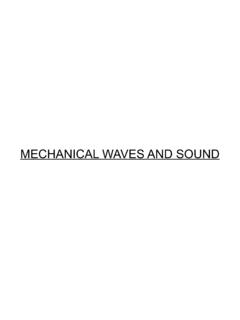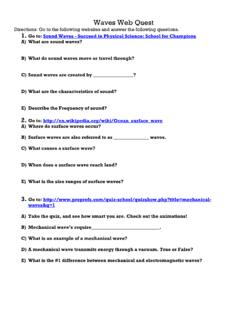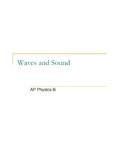Transcription of What are waves? Tsunamis m - COSEE NOW
1 what are waves ? Water waves are a manifestation of energy movingthrough the ocean. In their simplest form, waves aresinusoidal in shape. The high water levels are thewave crests and the low water levels are the wavetroughs. The vertical distance between a crest andtrough is the wave height H. The distance betweentwo crests or troughs is the wave length L and thetime it take for two crests or troughs to pass thesame point is the wave period T. The velocity, C, at which a wave moves through theocean is related to the ratio of its wave length towave period: C = L/T The wave length isproportional to the square of the wave period, L ~ T2so longer waves move faster than shorter ones.
2 The amount of energy, E, in the wave is a function of the wave height and is proportional to: E ~ 1/8 H2. what causes waves ? A disturbing force is necessary to create waves onthe ocean surface. The type of disturbing forcedetermines the characteristics of the generatedwaves. The 3 main wave generation forces in orderof decreasing wave period are: m Gravitational Attraction of Moon and SunproducesTides m Earthquakes and Underwater Landslides generate tsunami m Wind Stress over the ocean generates Wind waves Tidal waves Tides are generated by the gravitational attraction ofthe earth, moon and sun.
3 On the side of the earthclosest to the moon, the ocean surface bulges out Tsunamis Often misnamed tidal waves , Tsunamis are longperiod waves that originate when a strongearthquake or landslide occurs under the motion of the earth sends a strong impulse ofenergy into the water generating surface waveswith open ocean heights of less than 2 feet butwith wave lengths of over 100 miles and wavespeeds approaching 500 miles per hour! As a tsunami approaches the coast, the waveinteracts with the shallow bottom.
4 Because of theirlong wave lengths Tsunamis rarely break along thecoast. Instead the water runs up along the shoresimilar to the tide. In some cases where the coastis close to the center of the earthquake the watersurge associated with a tsunami can reachelevations over 100 feet high. Damage tolighthouses over 150 feet above sea level hasbeen documented during tsunami events. Wind Generated waves Wind blowing across the surface of the oceantransfers energy into the water. Initially, light windsgenerate small Ripples called capillary waves onthe water surface.
5 If the wind increases, the added roughnesscreated by the capillary waves increases the rateof energy transfer and waves begin to form on theocean surface. In the the region where wind is blowing across theocean surface and waves are being generated,the sea surface is characterized by steep waveswith many different lengths moving randomly inthe direction of the wind. This condition is referredto as sea. How large the waves get is dependenton3factors:toward the moon. An equal bulge in the surface ofthe ocean occurs on the side of the earth oppositeof the moon due to the centrifugal force generatedby the earth s rotation.
6 In between the 2 bulges theocean surface is depressed due to the movement ofwater toward the bulges. As the moon rotates around the earth, the bulgesmove as well resulting in 2 high and 2 low tides perday at most locations on the coast with a tidal periodof approximately 12 hours. The exact number of the tides is dependent on theshape of the ocean bottom along the coast. This canhave a significant effect on the height and period ofthe tide along the coast as seen in the tidal curvesfor the east coast. Some coastal geometries have the right size andshape to produce amplified tides that result in verylarge tidal ranges.
7 Some locations in the Bay ofFundy, Nova Scotia experience a tidal range of over40 ft! In shallow coastal regions, the currents generatedby the incoming tide can produce Tidal Bores,visible waves that move inland from the coast. m The strength of the wind m The amount of time the wind blows m The distance (called fetch) over which the wind blows in a straight line across the ocean The stronger the wind and the longer it blowsacross the fetch, the larger the sea will become. Afully developed sea occurs when the wavesreach the maximum size possible for a specificwind, duration and fetch.
8 Swell When waves travel out of the region of strongwinds, they become sorted as the longer wavestravel out from the storm faster than the shorterwaves. This results in waves of similarcharacteristics moving together across the oceanin groups. waves lose very little energy as theypropagate across the deep ocean. Removed fromthe influence of the wind the wave crests of theswell become rounded. All About waves SSSuuurrrfff sss UUUppp!!! photo by Jon SullivanCOASTAL PROCESSES COOPERATIVE EXTENSION This publication was supported by the National Sea GrantCollege Program of the Department of Commerce sNational Oceanic and Atmospheric Administration underNOAA Grant #NA16RG1047.
9 The views expressed herein donot necessarily reflect the views of any of these This fact sheet was prepared through theStevens New Jersey Sea Grant CoastalProcesses Cooperative Extension formed topromote the sustainability and wise use ofour coastal resources that provide the basisof a strong coastal economy. For additional information contact: Dr. Thomas Herrington Coastal Processes Specialist, Stevens Institute of Technology Castle Point on Hudson, Hoboken, NJ 07030 PH (201) 216-5320 FX (201) 216-8214 or photo by Jon SullivanOn beaches with gentle slopes, the wave crest breaks first and the white water spills down the face of the wave.
10 On very steep beaches, the does not break at all but surges up the beach instead. Current Wave Conditions For real-time information about ocean wave conditions see the following web pages: Photo courtesy of the NOAA Marine Prediction Surge associated with the 1946 tsunami thatstruck Hawaii. Notice height of white water alongtree trunks. Merchant Vessel in fully developed sea. Photo courtesy of the Pacific tsunami Museum Wave Shoaling and Refraction When waves enter shallow water (water depthsequal to the wave length) friction generated bythe seabed begins to slow the motion of the waves .










